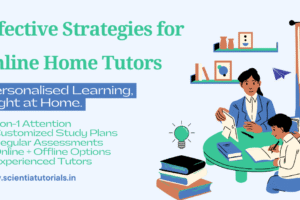Mastering the Art of Versatility: Teaching Tips for Home Tutors on Preparing Home Tutoring Lessons That Cater to Multiple Subjects
Introduction
In the world of home tutoring, versatility is key. Many students require assistance in multiple subjects, necessitating a unique approach to lesson preparation. As a home tutor, your ability to cater to different academic needs while maintaining student engagement is vital for fostering a love for learning. This article explores effective teaching tips for preparing home tutoring lessons that cater to multiple subjects, enabling you to create a dynamic and stimulating educational experience for your students.
Understanding the Importance of Multi-Subject Tutoring
Home tutoring often involves working with students who face challenges in various subjects. This can include core areas such as mathematics, science, language arts, and social studies, as well as elective subjects like art and music. Here are several reasons why it’s important to prepare lessons that address multiple subjects:
- Holistic Learning: Students benefit from a comprehensive educational approach, allowing them to make connections between different subjects.
- Increased Engagement: Varying subjects within a single session can keep students interested and engaged, reducing the likelihood of boredom.
- Skill Transfer: Skills learned in one subject often translate to another. For example, critical thinking developed in science can enhance problem-solving abilities in mathematics.
- Personalized Learning: Catering to multiple subjects allows tutors to tailor lessons according to individual student needs, preferences, and learning styles.
Strategies for Preparing Multi-Subject Lessons
Preparing lessons that cater to multiple subjects requires careful planning and creativity. Here are some effective strategies to consider:
1. Assess Student Needs and Goals
Identify Strengths and Weaknesses
- Before creating a lesson plan, assess your student’s strengths and weaknesses in each subject area. This can be done through initial assessments, discussions with the student, and feedback from parents.
Set Clear Objectives
- Establish specific learning objectives for each subject you plan to cover. Having clear goals will guide your lesson preparation and help you measure progress.
2. Integrate Subjects for Enhanced Learning
Theme-Based Learning
- Design lessons around a central theme that incorporates multiple subjects. For example, if the theme is “The Solar System,” you can integrate science (learning about planets), language arts (reading and writing stories about space), and math (calculating distances between planets).
Cross-Disciplinary Projects
- Encourage students to engage in cross-disciplinary projects that require knowledge from multiple subjects. A project on environmental conservation could involve research (science), report writing (language arts), and creating presentations (technology).
3. Use Engaging Teaching Methods
Hands-On Activities
- Incorporate hands-on activities that stimulate student interest and encourage active participation. For example, you could use building blocks to teach geometric shapes in math and then relate these shapes to architecture in art.
Interactive Learning Tools
- Utilize interactive tools, such as educational apps or online resources, to make lessons more engaging. Platforms like Kahoot! and Quizlet can be used for quizzes that cover various subjects.
Incorporate Multimedia
- Use videos, podcasts, and infographics to present information dynamically. Visual and auditory aids can help reinforce learning and maintain student attention.
4. Differentiate Instruction
Adapt to Learning Styles
- Recognize that students have different learning styles (visual, auditory, kinesthetic). Adapt your teaching methods accordingly. For instance, a visual learner may benefit from diagrams, while an auditory learner may prefer discussions or lectures.
Provide Varied Assignments
- Offer a range of assignment types to cater to diverse strengths. For example, some students may excel in written reports, while others may prefer creative presentations or group projects.
5. Create a Flexible Lesson Plan
Outline and Structure
- Develop a flexible lesson plan that outlines key topics, activities, and assessments for each subject. Having a structured plan helps maintain focus, but flexibility allows you to adapt to the student’s pace and interests.
Time Management
- Allocate time for each subject within the lesson. For example, if you have a 90-minute session, you might spend 30 minutes on math, 30 minutes on science, and 30 minutes on language arts. Adjust the timing based on student engagement and understanding.
Sample Lesson Plan Structure
To illustrate how to prepare lessons that cater to multiple subjects, here’s a sample lesson plan structure based on a theme:
Theme: “Exploring Ecosystems”
- Objective: Students will understand the components of an ecosystem and their interdependencies.
- Subjects Covered:
- Science: Learn about different ecosystems, food chains, and the roles of producers, consumers, and decomposers.
- Language Arts: Read a chapter from a book about ecosystems and write a summary.
- Math: Analyze data related to the population of various species within an ecosystem (graphs, averages, etc.).
- Activities:
- Science: Create a diorama of a chosen ecosystem.
- Language Arts: Write a fictional story about a day in the life of an animal in that ecosystem.
- Math: Collect and graph data about the animal population in a local ecosystem (field trip to a park).
- Assessment:
- Science: Evaluate the diorama and discuss the ecosystem’s components.
- Language Arts: Review the summary and creative story for comprehension and creativity.
- Math: Assess the graph for accuracy and analysis of data.
Encouraging Student Engagement
Engagement is crucial for effective learning, especially when covering multiple subjects. Here are additional strategies to keep students motivated:
1. Foster a Growth Mindset
- Encourage students to embrace challenges and view mistakes as learning opportunities. Discuss how effort and persistence lead to improvement in all subjects.
2. Celebrate Achievements
- Recognize student achievements, whether big or small. This could be through verbal praise, reward systems, or displaying their work prominently.
3. Build a Collaborative Learning Environment
- Encourage collaboration among students, especially during group projects. Collaborative learning fosters teamwork, communication skills, and diverse perspectives.
Addressing Challenges in Multi-Subject Tutoring
While preparing lessons for multiple subjects can be rewarding, it also presents challenges. Here are some common challenges and solutions:
1. Time Constraints
Solution: Prioritize topics based on the student’s needs and focus on the most critical areas. Use a timer to manage time spent on each subject effectively.
2. Varying Levels of Difficulty
Solution: Assess the complexity of each subject and adapt accordingly. For subjects where the student excels, consider introducing advanced topics or projects to maintain interest.
3. Balancing Curriculum Requirements
Solution: Stay informed about the curriculum standards for each subject. Align your lesson plans with these standards to ensure that all necessary topics are covered.
Conclusion
Preparing home tutoring lessons that cater to multiple subjects requires creativity, flexibility, and a student-centered approach. By understanding the importance of multi-subject tutoring, employing effective strategies, and fostering a collaborative learning environment, home tutors can enhance their students’ educational experiences significantly.
Encouraging parental involvement, celebrating successes, and addressing challenges can further strengthen the tutoring relationship. Ultimately, the goal is to create engaging and meaningful lessons that inspire a love for learning across various subjects, equipping students with the skills and knowledge they need for long-term academic success. As a home tutor, your role in this process is invaluable, shaping not just the minds of your students but their attitudes towards lifelong learning.



